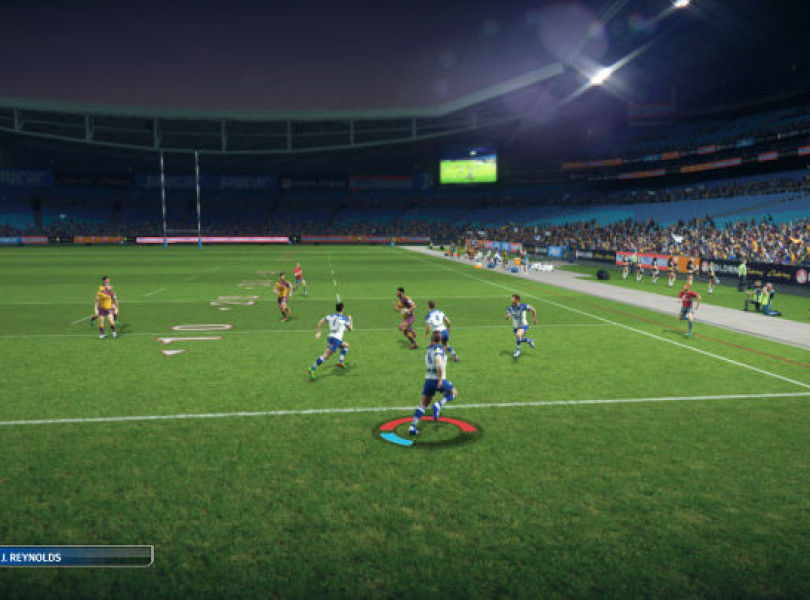A few points shy of the A-League.
When developer Big Ant Studios makes a sports simulator, it really takes the term ‘simulator’ seriously. Anyone familiar with Big Ant’s most recent sports simulator, Don Bradman Cricket, will know the developer prides itself on digitising as many facets of the real-life sport as possible. Rugby League Live 3 is certainly no exception to this.
That’s also one of the initial hurdles to overcome. Like Don Bradman Cricket, Big Ant has little interest in holding the player’s hand. While there is some assisted training in Rugby League Live 3 by way of drills, these are limited to goal kicking, passing, tackling, and play-making. These drills are gamified to the point where they’re more enticing for seasoned (or returning) players, rather than those learning the game mechanics for the first time.
If you’re unfamiliar with the specific rules of rugby league, Rugby League Live 3 won’t teach you. Early on, most of my training came from tabbing through the loading screen tips. There is a so-called training mode within the drills that can be toggled on or off, but the on-screen prompts are unfittingly matched with a slow-motion system that encourages bad habits more than it helps to perfect timing. Make no mistake: timing is one of the most crucial components of Rugby League Live 3.
It took me a few hours to discover the best training was hidden in the help menu, albeit in static form. Clicking through dozens of screens helped me wrap my head around new tactics and possibilities that weren’t covered anywhere else. Before stumbling on these tips, I was struggling to hold my own on the second-lowest difficulty level.
There are five difficulty levels in total, and those searching for an arcade experience will find the best match is the lowest one. This mode is laughably easy, as the game takes care of defensive manoeuvres, with perfectly timed automated side-steps, goosesteps and fends. It also dumbs down the opposing AI to the point that it makes you feel like a conscience-less A-grade player smashing through an Under 12s match.
It’s probably the best difficulty to learn the controls, mechanics, and timing, however, creating the gameplay foundation for the offensive and defensive strategies that are essential on higher difficulties. Jump the challenge up a notch to the inaptly named Amateur level, and a lot of that handholding is out the window.
From this difficulty level onwards, learning to master the right stick to avoid tacklers is essential. It becomes trickier when cycling through the many camera perspectives, as the left-stick movement controls and left/right-bumper passing shift relative to the new perspective (as they should), but the right stick functions do not. For me, this meant rewiring a natural instinct that would have preferred both sticks to be harmonious in relation to the new camera perspective.
There are also a couple of other controller fumbles. Stealing the ball is one of two buttons, depending on whether you’re looking at the help menu or the control screen. In the same breath, it’s frustrating that a right-hand repositioning is sometimes required on a default controller grip, given that the right trigger controls sprinting, while right bumper handles passing to the right of your player. Worse still, the controller sporadically drops out during matches: online, it’s less of an issue because you can instantly reconnect, but for solo play, it nullifies any match contributions to XP-rewarding challenges as soon as you reconnect to the game.
Hit-ups, side-steps, goosesteps and fends have specific situations when they are more effective, but they also have the downside of slowing down forward momentum. Even if you make a break, there’s no radar to indicate what defenders might be ahead of you, so sound knowledge of field positions and fast reactions are recommended to turn a break into a try. On top of this, every camera angle seems to have a distinct downside, with no one camera angle that worked effectively for spotting offensive opportunities or tracking defensive weaknesses.
That being said, scoring a try is exactly the kind of edge-of-your-seat experience that it should be in this type of game. Individual players have meaningful personalised attributes, particularly as it relates to speed and weight, both of which are taken into account when they collide with defenders. A heavier player has a better chance of smashing through a lighter defender or, when tackling, can use that weight advantage to force a player over the sideline. Faster players come onto the ball quicker, which is perfect for sneaky passes, and these quicker footballers are your best bet at breaking through a small defensive gap before the opposing team can react.
This becomes even more apparent when playing online, as both offensive and defensive AI seem to be set quite low. Defenders will often mill around and watch a human opponent fly by them, jogging backwards instead of turning to chase. When attacking, too small a gap on the blind side means a winger will flank around to the open side, which can embarrassingly result in a pass over the side line where there was a player a second before.
The best tactic for winning, like the last two games in the series, is to pass the ball to your team’s fastest player and have them zigzag up the sideline. While the AI defenders watch the human-controlled attacker fly by, you’ll be frustratingly mashing the left trigger to coax the game into selecting one of the AI lugs to perform a tackle. In fairness, this auto-select option works the vast majority of the time, but it most noticeably comes apart in situations where you need it to select the player closest to the attacking player who’s about to score.
On the positive front, stamina plays a big part in Rugby League Live 3, and it’s more nuanced than simply controlling how long a player can sprint. In defensive terms, low stamina impacts a player’s effectiveness when tackling and their discipline in line formation. While regularly sprinting to pick or make gaps is advised, it also comes at the risk of running players ragged to the point that when possession switches, your defensive line isn’t as effective. You can get the game to automatically substitute players for you, but it’s also well worth taking care of this manually to keep your players fresh, even in shorter matches.
Speaking of which, casual matches are on offer for those seeking a quick rugby fix, complemented by bigger showdowns in the form of grand finals or a State of Origin decider, while dedicated players can start a career mode, as a coach, rookie player, or existing player. It’s worth noting that controlling an individual player in career mode further highlights the issues of relying on defensively inconsistent friendly AI players.
There are various licenced competition leagues and tournaments to play in too, and any league, team, or specific player/referee that hasn’t been covered in the release, can be downloaded in the community-created FanHub section. Even without the fan-created content, there are more than 100 teams from global rugby league comps.
The presentation is strong, too. Iconic commentators Andrew “Vossy” Voss and Phil “Gus” Gould make you feel as though you’re on the pitch. The crowd roars as Vossy and Gus narrate your efforts with the kind of enthusiasm fans have come to expect, and it leads to incredible moments, from a big hit in a tackle, to a runaway try. Outside of rare instances where they get it wrong, the commentary is so diverse and on point that listening to the duo riff off each other and alternate commentary lines is as entertaining as playing the game (more so when it gets frustrating).
Rugby League Live 3 is close to being a great game. It’s certainly the best rugby game on new- and last-gen systems, but its steep learning curve, lack of training, AI weirdness, and returning sins from past games hold it back. It’s a shame, because when all the pieces click into place, this can be a compelling experience.






